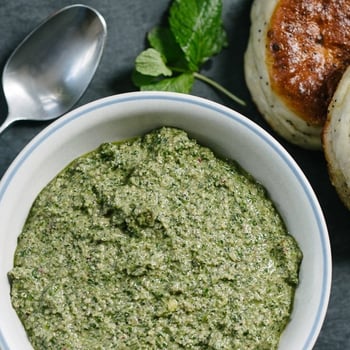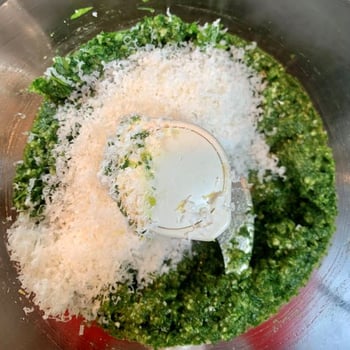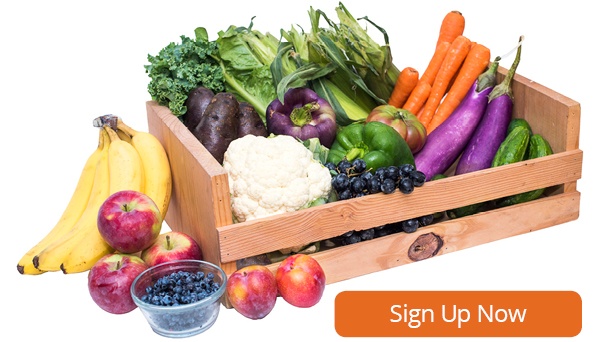Around these parts summer is pesto season! With the plethora of herbs and other pesto-friendly vegetables available during our New England growing season now's the time to capitalize on the bounty while filling your freezer. That way you'll have the taste of summer all year round.
Pesto is not just for pasta, it's also great:
- on pizza
- spread on a sandwich, particularly with chicken
- dolloped into soups like minestrone
- rolled into a pork roast
- mixed with fresh ricotta as a filling for ravioli
- stirred with mayo and yogurt or sour cream to make a dip
- drizzled over simple broiled or grilled fish
- topping baked or boiled potatoes
- over grilled or roasted vegetables
- the possibilities are endless!!
Not surprisingly pesto comes from Italy, specifically the Italian word, pestare, to crush. Traditionally made with a mortar and pestle (there's that pestare root again), it's texture can range from a thick paste to a thin puree: chef's preference, after all beauty is in the eye of the beholder. The version of pesto we tend to be most familiar with is made from basil, garlic, pine nuts, olive oil and parmesan - Pesto alla Genovese. But this basic outline of herb, garlic, nuts, olive oil and cheese lends itself to endless variations!
Herbs/Vegetables for pesto:
Arugula, celery leaves, garlic scapes, grape or cherry tomatoes, kale, mint, parsley and roasted red peppers
Nuts for pesto:
Almonds, macadamias, pine nuts, pistachios and walnuts. Even sunflower seeds!
Cheese for Pesto
Parmesan is traditional but pecorino romano, manchego, cotija, fresh ricotta and ricotta salata all make great pesto variations. Or go cheese-less with nutritional yeast instead.
Basic Pesto Recipe
- 2 cups packed herb or other vegetable (see above) Note: Variations with garlic scapes, tomatoes and red peppers benefit from the addition of about 1/2 cup of basil.
- 2-4 cloves garlic, to taste
- 1/4 cup nuts, toasted
- 1/3 - 1/2 cup olive oil, depending on your preferred texture
- 1/3 - 1/2 cup grated cheese, to taste
- Salt & pepper, to taste
- Other flavoring additions to consider include: lemon juice, red pepper flakes, anchovies
Directions:
Place herb/vegetable, garlic, nuts in food processor and pulse a few times to break down ingredients. Scrape down sides, then, with motor running, drizzle in olive oil so mixture become emulsified. Remove mixture to bowl, stir in cheese then taste and adjust for salt and pepper. Enough for about 1 lb pasta.
When serving with pasta be sure save a cup of pasta cooking water. After draining pasta add pesto and enough water for the sauce to throughly coat the pasta.
Pesto Recipes
If you're not quite ready to freewheel your pesto we've got these tried and true recipes that are sure to please!
Garlic Scape Pesto
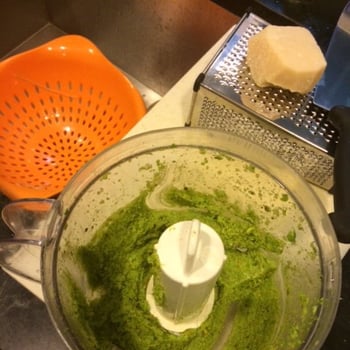
pea shoot and mint pesto
winter greens pesto
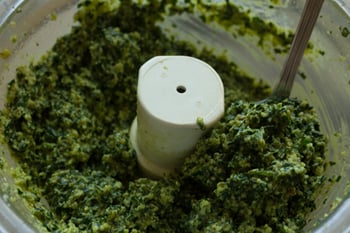
celery leaf pesto
Tomato Almond Pesto (alla Trapanese)
- 2 1/2 cups cherry or grape tomatoes
- 1/2 cup packed fresh basil
- 2 small or 1 large cloves garlic
- 1/4 cup slivered almonds
- Pinch red pepper flakes
- 1/4 tsp red wine vinegar, or more to taste
- 1/3 cup olive oil
- 1/2 cup grated parmesan
- Salt and pepper to taste
Place ingredients from tomatoes through red wine vinegar in food processor and pulse until finely chopped. Slowly drizzle in olive oil. Remove from food processor and stir in cheese. Taste and adjust for salt and pepper.
Buon appetito!


